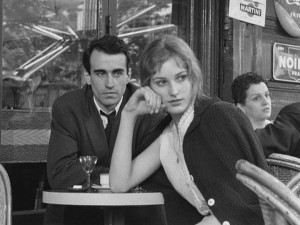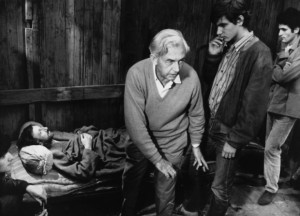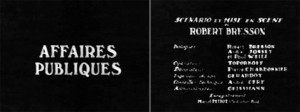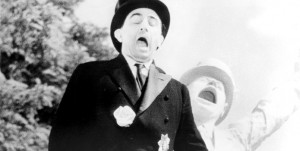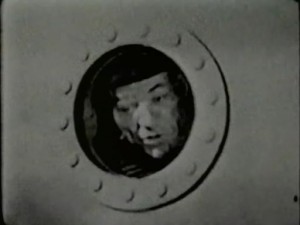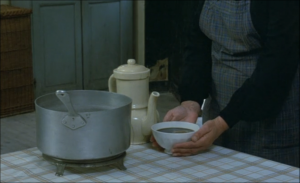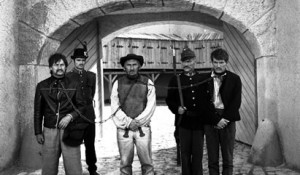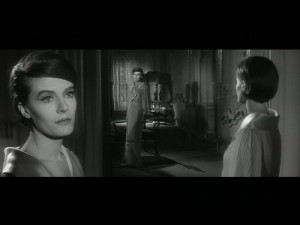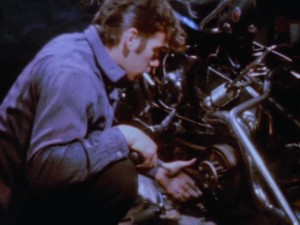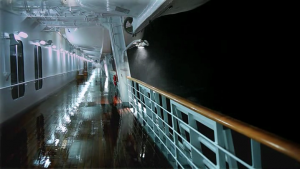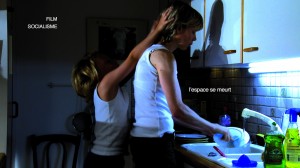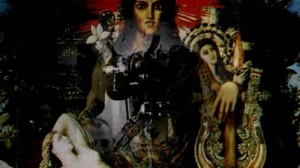Posted on Indiewire on January 6, 2012, with different illustrations. — J.R.
Critical Consensus: Kent Jones and Jonathan Rosenbaum Discuss Robert Bresson and Jean-Luc Godard
By Kent Jones, Eric Kohn and Jonathan Rosenbaum | Indiewire January 6, 2012 at 11:20AM
Editor’s note: Critical Consensus is a biweekly feature in which two critics from Indiewire’s Criticwire network discuss new releases with Indiewire’s chief film critic, Eric Kohn. Here, Jonathan Rosenbaum (formerly of the Chicago Reader) and Kent Jones (executive director of the World Cinema Foundation and editor-at-large at Film Comment) discuss two legendary filmmakers: Robert Bresson, the subject of a retrospective beginning at New York’s Film Forum today, and Jean-Luc Godard, whose “Film Socialisme” comes out on DVD and Blu-ray on January 10. More details on films opening this week follow after the discussion.
ERIC KOHN: There’s no easy way to have a short conversation about Robert Bresson without shortchanging a career spanning 13 films and widely considered paramount to 20th-century film history. Bresson’s Catholicism, his narrative precision, use of non-actors and painterly formalism have been analyzed many times over.
However, the Bresson retrospective that begins at Film Forum today ahead of a national tour, and includes 35mm prints of 11 films, is the first one in 14 years. Jonathan, around the time of the last major Bresson retrospective, you wrote in the Chicago Reader that Bresson’s work may have trouble surviving “because most of it doesn’t ‘translate’ to video.” You cited his extreme attentiveness to sound and framing techniques as qualities best appreciated in the theater. In the years since you wrote that piece, the marketplace has shifted from video to DVD and Blu-ray, improving the quality of home viewing. Anyone with a Hulu Plus account can watch a high-resolution version of “Pickpocket.” What do you consider to be the lasting appeal of watching Bresson films on a big screen in 35mm?
And are there any films in this latest retrospective that you would like to single out as under-appreciated or worthy of reevaluation?
JONATHAN ROSENBAUM: First of all, Eric, just for the record, there are 14 Bresson films — that is, films written and directed by Robert Bresson — and not 13. The missing item is, of course, the earliest, “Les affaires publiques” (1934), a comedy short whose only surviving print is regrettably slightly abridged (missing, I’m told, one or two musical numbers). Unfortunately, this has been missing, to the best of my knowledge, from most or all of the Bresson retrospectives.
It seems that overlooking of this film has in recent years become almost systematic; reviewing Tony Pipolo’s mainly superb “Robert Bresson: A Passion for Film” for Cineaste, I noted “a determination not to regard […] Bresson’s uncharacteristic first film as a significant part of his oeuvre — which even leads Pipolo to conclude his first paragraph by saying, ‘In forty years he made only thirteen films” (which would have of course been correct if he had said ‘features’ instead of ‘films’), and to assert, repeatedly, that ‘Les Anges du péché’ is Bresson’s ‘first film,’ restricting virtually all his discussion of this comedy short to an almost invisible footnote to the book’s penultimate chapter.” I wrote about this film at some length for Film Comment several years ago, but that piece isn’t available online. [2014 postscript: Now it’s available, here.] As a judicious and thoughtful early account of the film in Sight and Sound, shortly after a print of it was found in 1987, I would highly recommend “Lost and Found: Beby Re-inaugurates” by the late Gilbert Adair, which Michael Brooke recently posted here.
Regarding the importance of viewing Bresson’s work on film rather than other formats, I was thinking chiefly and specifically of the relation in Bresson’s work between sound and image. The sound in a film is generally perceived as being in the background relative to the image, whereas the sound in video formats is more often perceived as being in the foreground. I’m not thinking so much of the setup of the equipment as I am of the way we tend to layer image and sound in our own perceptions. Viewing Bresson films on video disturbed and altered this relationship and when I once tried watching “L’argent” on VHS many years ago, I even felt that the film no longer existed in that format. Since then, watching excellent versions of “A Man Escaped” and “Pickpocket” on DVD led me to revise my opinion of this overall principle somewhat. But I think it’s worth adding that every viewing situation tends to be somewhat different. An excellent setup for watching a film on DVD can be superior to the experience of watching a bad 16mm print, but that doesn’t mean that it will always play out that way; for me, there are too many variables to allow for any monolithic judgments on that score.
As for the Film Forum retrospective, I should note that although “Four Nights of a Dreamer” doesn’t really qualify as one of Bresson’s major works — even though it does contain one of his greatest sequences, the exquisite and mysterious passing of a bateau mouche under a bridge — it’s become one of the most neglected because it’s been so difficult to see thanks to some rights issues. My two favorite Bresson films at this point are probably “A Man Escaped” and “Au Hasard Balthazar,” but I hasten to add that most of the others remain for me essential works; the only ones at this point that have mainly failed to engage me are “Les Anges du peché” and “The Trial of Joan of Arc,” and this may be at least partially because of cultural lapses on my part. (Tony Pipolo, among others, has plenty of interesting things to say about both films.)
Kent, in a 1999 article for Film Comment, you wrote passionately against the common description of Bresson’s films as “transcendental,” a generalization you felt came at the express of understanding his evolution as a filmmaker. In your BFI book about “L’Argent,” you discuss seeing the film for the first time and focusing on “sensual details” before delving further into other aspects of its appeal. If Bresson’s films are rooted in the present moment, then the broad range of subject matter in his work would appear to represent a vast range of human experiences. But are those experiences universal, or does one need to feel particular empathy for a Bresson protagonist—whether it’s the alienated young girl in “Mouchette” or the desperate, unemployed Yvon in “L’Argent”—in order to fully understand the mastery at work? And while there’s no doubting the value of Bresson’s technique, can you single out any instances where anyone other than Bresson has successfully applied it?
KENT JONES: I have nothing against the word “transcendental” per se, but I do have a problem with the employment of it as a tag. Paul Schrader used it judiciously. His book [“Transcendental Style in Film”] was about three filmmakers, but the word stuck to Bresson (but not to Ozu or Dreyer), and became frozen and all-defining. It also became more or less interchangeable with “Jansenist,” “Catholic” and “Christian.” Which then led to a furious and concerted effort to discuss Bresson in a “de-Christianized” context. “Political,” “erotic,” “materialist,” “revolutionary,” anything but Christian. This seems counterproductive to me. Looking at Bresson’s movies through the lens of institutionalized religion is obviously reductive and contrary to the spirit of his films, but denying the crucial importance of Christian redemption and Christian imagery in the work is a losing proposition. It’s common among people writing about cinema to remake their favorite filmmakers according to an ideal image. From my perspective, the problem originates with a fixation on judgments and interpretations that pin filmmakers in place, as opposed to a just description of the action of the work, the gesture, the action.
Take those “sensual details.” The scenes with the old woman in “L’Argent” – she brings the bowl of coffee to the old man, he slaps her, there’s a cut to the coffee spilling over and onto her hands; he breaks a glass, she immediately stops what she’s doing, turns around, gets a sponge, gets down on her knees and cleans up the glass. As Jonathan says, the relation between image and sound is never less than crucial – the sound of the coffee spilling, the woman’s footsteps, the clicking of the fragments of glass. The sound is almost always denatured, removed from its ambient context and isolated (and often recorded by Bresson himself). When you hear a sound in Bresson, you really hear it; and when you see an action or a person or an object, you really see them. Which draws you into a state of heightened, extra-sensitive perception – perception of Bresson’s peculiarly vigorous, excited approach to storytelling, and, by implication, to on-going reality, inside and outside the theatre.
Regarding the distinction between “universal experiences” and the need to feel “particular empathy” for Bresson’s heroes and heroines, I suppose you’re getting at the question of identification and whether or not it’s rendered moot by Bresson’s filmmaking. Which leads us away from transcendentalism but toward transcendence: does his filmmaking “transcend” identification? I think there’s a great deal of confusion around this issue, a hangover from a widespread distrust of narrative in general from an earlier era.
On a very basic level, when you’re talking about narrative, you’re talking about identification. I “identify” with the prisoners in Jancso’s “The Round-Up,” to cite a film that’s supposed to be all about compositions and camera movement. I identify with Delphine Seyrig in “Last Year at Marienbad” and the lovers in “Blissfully Yours.” On the other hand, I don’t really identify with any of the bikers in Kenneth Anger’s “Scorpio Rising” because they are, more or less, objects of aesthetic fascination which we are invited to study as if they were on display in a cabinet of wonders. All the same, though, the minute one of them picks up a tool or a rag, I’m curious, and engaged with his humanity.
The confusion arises from our familiarity with a certain strain of identification in a certain strain of narrative, made possible by techniques (of narrative construction and acting) which we all know, branded at a certain historical juncture as pernicious, coercive and ideologically determined. Which led to the strange notion that a select group of filmmakers avoided, bypassed, or, in Bresson’s case, transcended identification. I think this is nonsense.
Of course there is identification in Bresson – it just happens at a different level from where it happens in, say, “Rio Bravo” or “Husbands” (or, for that matter, in “Tintin” or “Transformers 3”). Of course one identifies with “Mouchette” or Yvon, Joan of Arc or Fontaine. It’s important to remember that on the level of narrative incident, Bresson’s films are straight out of 19th-century fiction. On a more local, moment-by-moment level, they’re obviously something else again. One becomes attuned to the auras of people, stripped of any possibility of defense or subterfuge. The risk, I think, is in their interchangeability: One could imagine Luc Simon as Yvon and Christian Patey as Lancelot, or Antoine Monnier, the hero of “The Devil, Probably,” in the role of the pickpocket. But that is also a strength, because it reinforces the idea of chance in human affairs: this person exists now under these circumstances. There’s a powerful sense of chance in Bresson.
There is an idea of Bresson as somehow immaculate and ineffable, and I think this is unfortunate simply because it’s a lot to pin on any artist. The melodramatic plot twists in certain of the films can be a little awkward, the representation of certain actions can at times be broken up in a manner that runs counter to the film itself (one winds up putting the pieces of the spatial puzzle together and temporarily abandoning the flow of action). But to say that Bresson’s films aren’t perfect is to humanize him and relieve him of the burden of an impossible fantasy. One could find similar “shortcomings” in Hitchcock or Hawks or any great filmmaker. When the filmmaker is that engaged, the tyrannical question of perfection is rendered irrelevant.
As to the question of other filmmakers “applying” Bresson’s technique, I simply don’t believe that such a thing is possible – no artist can apply another artist’s technique (an overused term of limited use). Again, we’re back to the question of tags and frozen judgments. One could easily make the mistake of characterizing Bresson’s particular approach to filmmaking as some kind of transcendental system. But one need only look at the work of certain filmmakers who really have chosen to work under the sign of Bresson – Aki Kaurismaki, Hal Hartley’s early films, Darezhan Omirbaev – to understand the fallacy. Omirbaev, whose work is all but unknown here, is closest to Bresson, but his films are, finally, vastly different.
JR: I agree absolutely with Kent that there’s no way that “Bresson’s technique” could or should be “applied” by any other filmmaker — as if it were, say, a coat of paint. Which is to say, at the risk of repeating a truism, that you can’t separate that technique from his view of the world or any other aspect of his content.
And it’s worth adding that Bresson was by no means monolithic in believing that his methodology had to be adopted by others: To cite examples of radically un-Bressonian cinema that he admired — quite apart from his enthusiasm for “For Your Eyes Only,” a late James Bond feature, that he expressed in one of his last TV interviews (available on New Yorker’s “L’argent” DVD) — Charlie Chaplin was one of his favorite filmmakers, and he also passionately defended Orson Welles’s “Macbeth” when it came out. And when he opposed cinema to theater in many of his theoretical statements, this didn’t mean rejecting theater on its own terms; it meant, rather, that he was enough of a purist to question the notion that theatricality was inherent to cinema. And the fact that he tended to stand apart from the remainder of French cinema, much as Jacques Tati did, doesn’t necessarily mean that he was opposed to all those films — or, if he was to some degree, it wasn’t at all comparable to the way that Nagisa Oshima has condemned all of Japanese cinema on sociopolitical grounds.
One of his most essential concepts, and one of the most fascinating, was the conviction that expressiveness in film should arise not so much from images or sounds in their own right as from relationships between shots, or relationships between sounds and images. He also maintained that he would replace images with sounds whenever he could, because, at least by implication, the images that sounds provoked people into imagining were more potent than those that appeared on the screen. And this comes very close to articulating one of the basic aesthetic principles espoused by Welles, supposedly Bresson’s precise opposite, who declared in the ’30s — well before he started making films, and on the basis of his work in radio and theater — “I want to give an audience a hint of a scene. No more than that. Give them too much and they won’t contribute anything themselves. Give them just a suggestion and you get them working with you.”
This ties in with Kent’s strong argument against fixing “on judgments and interpretations that pin filmmakers in place”—that is, reducing them to formulas and recipes. So it’s also bracing to know that, years before he succeeded in raising the money to make “Lancelot du lac” with nonactors in the 1970s, Bresson wrote a letter to George Cukor in Hollywood asking for his help in persuading Burt Lancaster to play Lancelot and Natalie Wood to play Guenièvre. (If you don’t believe me, you can look up this letter; it was published years ago in Positif.) In other words, just as Freud couldn’t always be blamed for the Freudians, Bresson didn’t always feel obliged to behave like a Bressonian.
Some of this pinning of filmmakers in place can undoubtedly be ascribed to a certain misguided or displaced reverence. I’m fascinated by the fact that back in the early ’60s — when I was first getting acquainted with art cinema (and saw my first Bresson film, “Pickpocket,” when I was a freshman at NYU, at Amos Vogel’s Cinema 16) — he was regarded as a joke, even to some extent by his admirers. A standard Bresson gag throughout the ’60s and much of the ’70s among cinephiles was a riddle: “Why do Bresson’s actors always look down at the floor?” Answer: “In order to follow the chalk marks.” Whereas today he’s no longer regarded as marginal in the same way that he used to be—which is also true of Andrei Tarkovsky. And think about the prestige enjoyed today by Pedro Costa, and all the retrospectives around the world devoted to him, which challenge the notion of him being “neglected” — unless one equates recognition with, say, the Oscars, or long reviews in The New Yorker. (I recently posted something on my web site about this.) My point is that, thanks in part to the distribution and dissemination made possible by DVDs, and despite the losses entailed by digital formats, seriousness and difficulty have become positive values among many film buffs to a degree unmatched by the so-called Golden Age of the ’60s. Or so it seems to me.
EK: Kent, your point that no artist can possibly duplicate the approach of another artist is well taken. It also provides us with a nice transition into our other topic of conversation and a filmmaker who most certainly cannot be copied by anyone: Jean-Luc Godard’s “Film Socialisme” hits DVD on January 10. While the movie has run its course at various festivals and in theatrical release, its divisive nature — notable from its intermittent appearance on top 10 lists and absence from so many others — continues to define its public reputation.
There’s no doubting that Godard’s layering of multiple narratives, which form both a critique of Western civilization and an intimate (if enigmatic) family portrait, shows a rather astounding command (or at least comfort) with the medium he has explored for more than half a century. Unlike Bresson, Godard’s entire output isn’t a stationary filmography, but a compelling work in progress. And yet so many otherwise astute viewers fail to appreciate any of it, a phenomenon that surfaced in rather ugly terms when “Film Socialisme” premiered at Cannes. At that time, Jonathan, you wrote that you had seen it without the infamous “Navajo English subtitles“ that enraged non-French speakers. Since then, have you seen it in the format that showed at Cannes?
And pivoting off Kent’s idea that treating Bresson’s career as “immaculate” works against him, it appears the opposite issue afflicts Godard’s reputation. When I wrote about “Film Socialisme” at Cannes, I deemed it the scandale au festival — not because it was a subversive or fiery provocation, but rather because numerous critics refused to engage with it on any level. It provoked confusion and, worse, ambivalence. Do you think Godard intended this reaction and does it add on some level to the value of the work?
JR: I think that what turned “Film Socialisme” into such a scandal at Cannes was based on many factors. Some of these should be ascribed to Godard, but others have to be ascribed to some of the crasser mercantile reflexes that tend to rule critical first impressions (which often prove to be the final judgments) at this annual event—the same reflexes that, for me, conceivably make the press-and-industry screening audiences at Cannes the worst ones I’ve ever experienced anywhere.
Starting with the crass responses, I think the film’s title itself was tantamount to waving a red flag in front of a bull, at least as far as the American press was concerned. Is there any dirtier word than “socialism” in American culture right now? But it’s obviously a significant and important title for Godard, even an essential one, because the two words that compose it stand for what he clearly regards as the two great lost dreams and dashed hopes of the 20th century, an occasion for mourning. Overall, I think much of the Cannes reaction took that title as a perverse provocation, not as an occasion for mourning anything at all except for Godard as a commercial property. The “Navajo subtitles” also stemmed from an honest conviction on Godard’s part that conventional subtitles involve various kind of dishonesty and false reasoning about how films in other languages should be engaged with—a position that obviously conflicts in a big-time way with the consumption model of immediate comprehension and instant judgment that rules at Cannes.
I would never presume to claim that “Film Socialisme” is an easy film to come to terms with, whether it has detailed English subtitles, “Navajo” English subtitles, or no subtitles at all, and I’ve watched the film in all three of these forms. Each form entails certain losses as well as gains–and the same is true for seeing “Histoire(s) du Cinéma” with sparse, detailed, or no subtitles (and with or without the alternate use of printed texts as supplements or crib sheets). The myth that comprehensive subtitles would make everything crystal clear and available for instant consumption is well worth demolishing. But I regret that many of the most contemptuous dismissals of the film at its premiere — most especially, I’m sorry to say, that of Todd McCarthy, my favorite industry reviewer — were founded on impugning Godard’s humanity, based on some stupid casual remarks he made during the early 1970s, when in fact “Film Socialisme” qualifies as the most tender and humane of all his late features, something that becomes immediately apparent when you consider its treatment of both children and animals.
I also think that some shots and transitions in the first part of the film are among the most beautiful and powerful to be found anywhere in Godard’s work. As a full work, I continue to find much of the film obscure — but the same is true for me of “Hélas pour moi,” which I like far less, and “For Ever Mozart,” which I actively dislike. Even though I tend to prefer Godard’s late video works to his late features, I would count “Film Socialisme” as one of the few exceptions to this rule, along with “Passion” and “Nouvelle Vague.” Every time I re-see (and re-hear) the film, in whatever form, I make many more discoveries.
The limitation to be found in practically all of Godard’s work ever since he moved back to rural Switzerland is that of self-imposed isolation, removing himself from the same film community where he presided as a central figure and guru for most of the 60s. In some ways, this has turned him into a crank and crackpot, some of whose root concepts are not only obscure but also highly debatable — such as some of his notions about both film history and the Holocaust in “Histoire(s) du Cinéma,” for instance, and maybe even some of his ideas about international finance in “Film Socialisme” (although this is an area where I feel far less qualified to judge), some of which might be compared to Tolstoy’s questionable and tiresome ideas in the polemical stretches of “War and Peace.” But this isn’t the same thing as claiming that Godard wants to be perverse or incomprehensible. On the contrary, every interview I’ve read or heard with him about “Film Socialisme” earnestly and honestly seeks to clarify what he’s saying–as does the best criticism I’ve read about the film, such as Andréa Picard’s.
EK: Kent, in Film Comment, you complained that Godard’s films “continue to be misperceived as rosetta stones in need of decoding.” But how else can one appreciate “Film Socialisme” without digging into its innumerable historical references and implied polemics? Additionally, some have speculated that “Film Socialisme” is Godard’s last film, or at least one of his last. Is there anything about it that you would consider a summation of his career?
KJ: I saw “Film Socialisme for the first time in Cannes, and while I largely agree with Jonathan’s assessment of the press and industry screenings at that festival, I don’t remember that particular screening as being noteworthy. It was more along the lines of “Chalk up another Godard film – time for lunch.” There was nothing like the mass exodus from “Colossal Youth,” for instance. Was it the “scandale au festival?” If so, it was an extraordinarily quiet one.
As far as my remark about rosetta stones, I’ll stick to that, but I need to provide a little context.
Deleuze once wrote – at the moment I can’t remember where – that Godard “invented a new way of thinking,” or something to that effect. I think this is correct. What exactly comprises that new way of thinking? From my perspective, it’s a hybrid, in which paradox, association and juxtaposition (visual, verbal and aural) join forces to create a potentially endless relay. Andréa Picard’s Cinema Scope essay, to which Jonathan refers, is indeed very good, but I can not agree that “Film Socialisme” is a “film essay.” Chris Marker and Jean-Pierre Gorin make film essays. Godard makes narratives which are sliced up, reconfigured, abandoned and finally exploded. What is left – intentionally, I think – is a ruin. And as Charles Péguy says in the quotation that opens Picard’s essay, “Ruins are eternal.”
To be clear, I am not using the word “ruin” pejoratively but descriptively. When one thinks of a film by Resnais or Kubrick, for instance, one imagines a solid construction. But from an architectural standpoint, Godard’s films are phantom structures with missing doorways and unfinished walls, moss-covered stairways and half-assembled plumbing. To a great extent, this is deliberate, of course. In his later films, Godard takes strands of narrative and builds over and under them, extends or atomizes certain motifs to the point where they become unrecognizable as elements of one single narrative.
His work in video, where he doesn’t bother with narrative at all (not counting “Grandeur et Decadence”), is another matter – I am referring to his extraordinary TV series “France/Tour/Détour/Deux enfants,” to the little seen and still fresh and surprising “Puissance de la parole,” to his incredible shorts “Soft and Hard,” “Liberté et patrie” and “The Old Place,” all done in collaboration with Anne-Marie Miéville, and the great “Je vous salue Sarajevo” and “L’Origine di XXIème siècle.” It’s not really correct to call these essays, either. They are meditations, excavations, explorations, analyses, elegies, cinematic poems – sometimes a little bit of each. As for “Histoire(s) du cinéma,” it stands absolutely alone – it is indeed a ruin, and one of the cinema’s grandest.
At this point, all the work is on video (actually, HD) and the narrative and non-narrative tendencies have all but converged, save for one crucial difference. When Godard works with [Anne Marie] Miéville, their texts are largely written and spoken by the filmmakers. When he makes a (semi) fiction(al) film without Miéville, the texts are largely assembled from multiple sources and sort of recited but sort of acted. This is an important distinction, because the movement from quotation to quotation can be difficult to follow and put together. Part of it has to do with the relationship between the people on screen and the words they’re given to speak, and with the actions they’re given to accompany those words. From my perspective, this accounts for the occasional “obscurity” that Jonathan mentions.
In 1966, in a harsh assessment of the man (and a mischaracterization of the work), Guy Debord wrote that there was “an absence of any real critiques of Godard.” True in 1966, true today. We haven’t really figured out how to talk about Godard. He is engulfed by polemics, either celebrated or dismissed. The newer films are interpreted, decoded, in certain cases annotated, but not quite described. Godard is approached softly, tentatively, and all too frequently on bended knee. And what I find so strange about the Godardians who police the internet in search of infractions and evidence of anything less than 100% approbation is that they assume a rhetorical and thematic neatness that reduces the films to a succession of ideograms. Every image and quotation stands for a clear idea, and the film is reduced to an oracular report on the state of the western world.
This approach deprives the films of what Jonathan calls Godard’s crank/crackpot tendencies, but more importantly it deprives them of a fair percentage of their mystery, their thorniness, and their awe-inspiring power. They are neither neat nor orderly, “solvable” nor “decodable.” I once characterized my problems with “In Praise of Love” in terms that were too harsh by half, but I included a quotation from Wallace Stevens that seems just as pertinent 11 years later: “…the probing of the philosopher is deliberate. On the other hand, the probing of the poet is fortuitous.” The poet has no obligation to be clear or absolutely precise; he or she has an obligation only to his or her own internal reality, which incorporates a vision of and relationship to the shared reality of public life.
To characterize Godard in purely political and historical terms is, paradoxically, to do him a disservice, because it places him at a little bit too great a remove from “the spirit of the forms,” to evoke Elie Faure. Given the fact that he has fought so hard for the image and against the dominance of the text, this is more than a little ironic. Godard is a poet of the image and a great one, and that is more than enough – he doesn’t have to be everything else.
Of course, he has created the same kind of problem for himself that Ezra Pound created with his Cantos (and by the way, I am not implying that Godard is anti-Semitic by introducing a comparison to Pound) – both poets have found themselves looking at western civilization from a great distance, finding errors and suggesting correctives. The fortuitous and the exploratory continuously segue into the deliberate – but unlike Pound, Godard always quickly segues back.
The characterization of Godard as a misanthropic charlatan is utterly contemptible and deserves to be tossed on the garbage heap along with that idiotic Times “think piece” about “aspirational viewing.” But I do not share the belief that any of his films is 100% coherent and unified. Rather, I agree with Alain Bergala that from “Passion” on, the work has come to us in an endless stream, resisting finality, drifting toward and away from cohesion – I once saw this as a limitation, but I no longer do. The recitation of texts is at times powerful and cogent and at other times purely musical and contrapuntal. The actions of the people onscreen are sometimes overwhelmingly eloquent (as was the case with the old couple in “In Praise of Love” or the husband and wife in the middle section of “Film Socialisme”) and sometimes obscure and perfunctory at the same time, playing out a monotonously aggressive form of slapstick (the two women from the TV station in the same section).
The movement from one image to the next, and the coordination between that movement and the interpolation of sounds, on the other hand, is never less than bracing, often astonishing. The political and historical cogency of Godard’s cinema has always existed within (and sometimes been overwhelmed by) a greater existential urgency, because the films are always asking: How do I (Godard) live? What is this thing called “I?” Who are these others like me but not me, and how is a “we” formed?
For those reasons, I do not see a neat address to the world in any of his movies, but a flow of gestures and shifts and “moves” (to use a term he once favored) in which insights and flowerings of thought come suddenly, violently. The movement of Spanish gold linked to the flowing of sparkling water in “Film Socialisme” does not, from my perspective, develop into a precise historical thesis as much as it provides a rhetorical setting in which the images and sounds on board ship ebb and flow into some of the most piercing moments in recent cinema, where the political, the historical and the existential merge.
This occurs throughout “Film Socialisme,” on certain cuts to the assaultive images and sounds of consumers literally and figuratively adrift, to the soliloquies of the bewildered father and the formidable yet delicate mother (the “Martin Family,” touching whether or not you know that their name is meant to evoke a resistance network) and to the movement from one image and sound to the next in the Palestinian section, where a quote from Scholem in a 1926 letter from Jerusalem (“the country is a volcano… the day will come when language will turn itself against those who speak it”) under a breathless montage of ignited violence and conflagration leads to Jakobson’s citation of the phoneme as the only possible means of separating sound from sense under an image of St. Jerome (who translated the bible into Latin), segueing visually into an image of scrolled texts suggesting an amplification device and aurally into a plea for two voices to speak together (“…only successful when dissonance is introduced by a common note”), followed by a dip to black, a still image of a soldier reading, a statue at a wall, converging girls’ voices in Arabic and Hebrew fading into the track under trapeze artists catching each other in mid-air by the sea in Varda’s “Les Plages d’Agnès,” followed by Joan Baez’s recording of “Where Have All the Flowers Gone?” in German.
I got into an exchange on a film website with someone who took Glenn Kenny and myself to task for not fully acknowledging the political and historical power and exactitude of this sequence. Of course, after only two viewings of the film with the Navajo English subtitles (my French is good, but not that good – and by the way, I agree with Jonathan here: something is lost with the complete subtitles in the opening section, gained in the following sections), both months apart and in the relatively distant past, being scoffed at by people who had “worked” on the movie left us in a comical predicament.
And none of us has adequately described the texture of the images or their duration, the glowing color, the sonorous quality of the voices, the slow and seemingly ineluctable movement of forms from Jerome to the scrolls. It’s a lovely passage, but perhaps not quite as shocking as those cuts to the dancing or praying or dining passengers. Or the red flowers that appear so suddenly amidst the green landscape in “Notre musique,” evoking the disappearing but still vibrant hopes of socialism with a physical impact. Or the amazing moment when the maid props up Lemmy Caution’s feet with a copy of Marx and responds to his question about working too hard with a business-like “Arbeit macht frei” in the too-little-known “Germany Year 90 Nine-Zero” – the historical amnesia of the new world order in one quietly shattering exchange.
Not all of Godard is that eloquent, but how could it be? To arrive at such moments is already enough.

